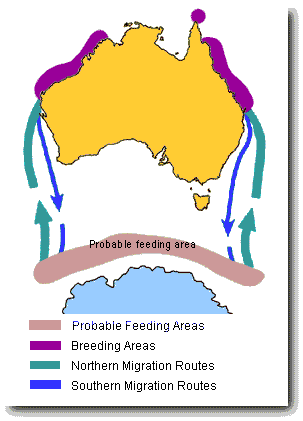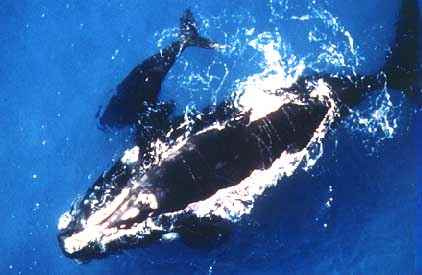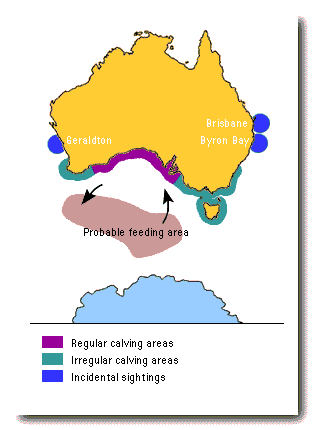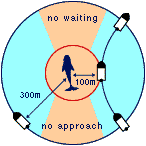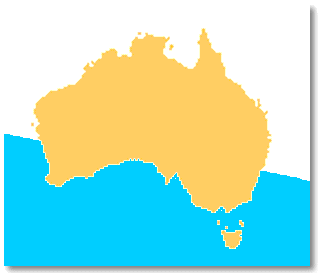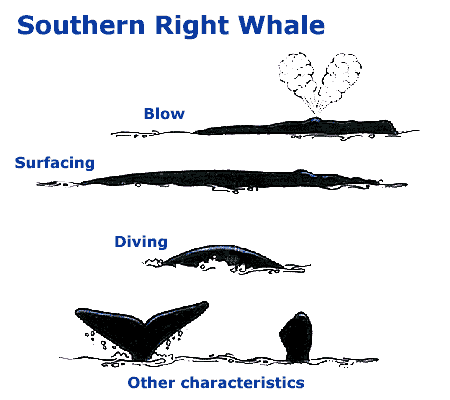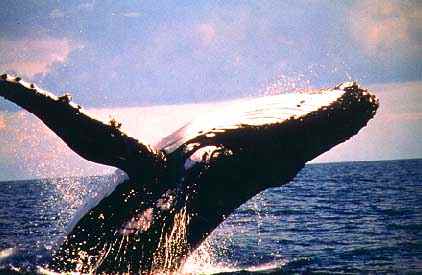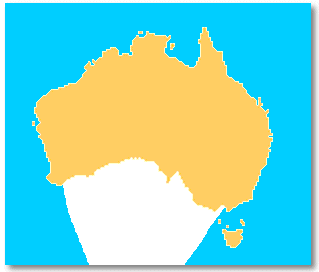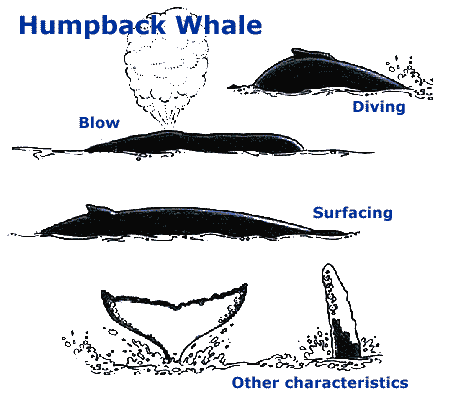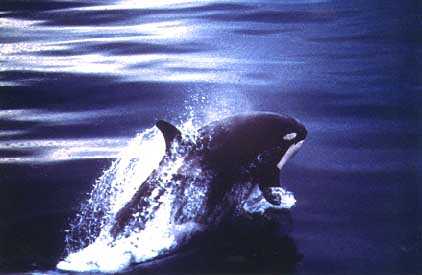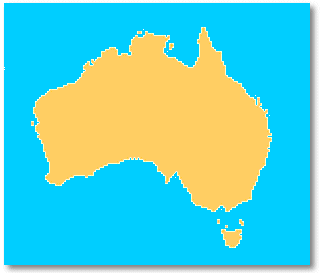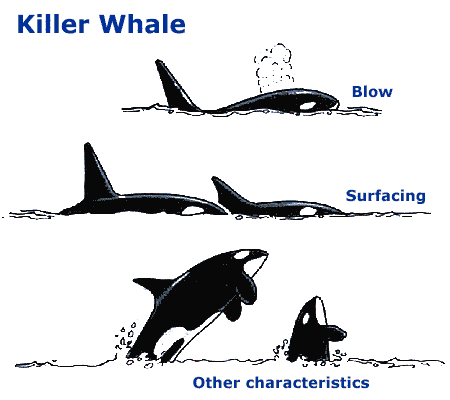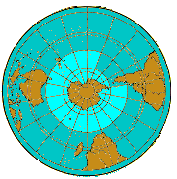Whale Dreams

Whale Dreams is the section of Oceans Alive devoted to whales and whale watching. Here you can find information about whales and where to see them in Australia, as well as links, details about various whale and cetacean projects in our region and details of other marine animal tracking projects around the world.
In Whale Dreams:
- Whale Spotting
- All about whale watching in Australia.
- Types of Whales
- A listing of information about the main types of whales you'll encounter in our waters and their migration.
- Global Whale Sanctuary
- Details of the international push to ban whale hunting. Australia is in the vanguard of this initiative.
- Characteristics
- The visual characteristics of the whales commonly seen in Australian waters
- Whale Song
- Hear the songs of the Humpback Whale
Whale Spotting
Each year most of the large whales in the southern hemisphere follow a general migration pattern. Summer is spent in the cold waters of Antarctica, where they feed on enormous quantities of the prawn-like krill. In autumn, as the temperature falls and ice begins to form on the sea surface, the whales begin their northward migration to more temperate, sub-tropical and in some species, tropical waters to give birth and to mate before returning to Antarctic waters at the end of spring.
Consequently, large whales are most likely to be seen in Australian waters between June and October. In total about forty species of whales and dolphins have been recorded in Australian waters.
From about May to August and later, humpback whales migrate north along the east and west coasts of Australia to breeding areas off Queensland, Western Australia and possibly waters further north. From September to December they return to feeding areas in the Antarctic.
The migration route is close to the coast so these whales can often be seen from prominent headlands. Humpback whales are regularly seen from Hervey Bay and Point Lookout on Stradbroke Island in Queensland, Cape Byron at Byron Bay in New South Wales, Point Quobba at Shark Bay and Ningaloo Marine Park in Western Australia.
Southern Right Whale and Calf.
Image courtesy of Environment Australia.From May to November, southern right whales appear close to the southern coast of Australia. During this period, females and calves spend a lot of time just beyond the surf break, and they can be seen frequently from headlands along the Otway coast of Victoria (particularly Warrnambool, Port Fairy and Portland Bay), cliffs along the Great Australian Bight in South Australia, near Cape Leeuwin and in bays along the south coast of Western Australia and Storm Bay in Tasmania.
Dolphins may be seen all year round in the coastal waters of Australia, and unlike the large whales some species may spend all of their lives in the one region. The species of dolphins most likely to be seen vary depending on the location but include the bottlenose dolphin, common dolphin and Irrawaddy dolphin.
A unique experience and possibly the closest encounter between wild dolphins and people occurs at Monkey Mia, Shark Bay, Western Australia. For many years, dolphins inhabiting Shark Bay have been daily coming into the shallow water. They swim around people's ankles, and are at times close enough to touch.
Tips For Whale Watching
- Take a good pair of binoculars.
- Choose clear, calm days in June through to October.
- Select a prominent headland or visit an area in your boat or aircraft where whales have been reported previously.
- Look for the blow of a whale, that is the cloud of spray or mist that appears as the air is exhaled through the blowhole. This is usually how whales are first seen.
- Within 300 metres of a whale, move at a constant slow speed no faster than the slowest whale or at idle, 'no wake' speed
- Avoid sudden or repeated changes in speed or direction
- Observe the distances set out in the illustration below
- Stopping? Allow your motor to idle for at least one minute before turning it off.
- No more than three vessels should attempt to watch a whale or group of whales at one time.
- Do not allow the whales to become boxed in, or cut off their path, or prevent them from leaving
- Do not approach mothers with young calves. Move away slowly at idle, 'no wake' speed to at least 300 metres from closest whale
Minimum Approach Distances
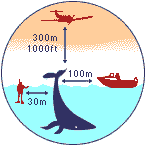
Further information on whale spottingEnvironment Australia has further information on whales, and whale spotting in particular:
- Where to watch
- Further tips on whale watching
- Facts and figures on whales in Australia
Information courtesy of
Environment Australia- Biodiversity Group
Types of Whales
Whale Types and Migration The freezing waters off Antarctica are the summer home for many whale species. While there, the whales feed on the rich supply of krill (small prawn-like animals). In autumn, as the temperature falls and ice starts to cover the sea, many of the large whale species begin a long and hard migration northward to the warm waters off the Australian coast. Humpback and southern right whales follow a similar route each year, and many females make the journey while pregnant so that they can give birth in Australian waters.
How many whale species are found in Australian waters ?
Types of Whales
There are three types of whales commonly seen from the shore in Australia:You can see the visual characteristics of the other types of whales here.
Southern Right Whale
(Eubalaena australis)Description:
Southern right whales are robust and have a strongly arched mouth and long baleen plates. Large white bumps (callosities) occur on top of the head, along the edges of the lower jaw and above the eye. Southern right whales have no dorsal fin. The flippers are large and rounded, and the flukes have a broad, smooth rear margin separated by a deep notch. The flukes are often lifted out of the water as the animal dives. Southern right whales are predominantly black, but some may have patches of white.
Distribution:
Dinstinguishing features:
Absence of a dorsal fin; strongly arched mouth; large callosities on the head.
Length:13 to 18 metres, average 15 metres.
Remarks:
Southern right whales migrate to the southern coasts of Australia each winter. Because of their habit of calving or resting with young calves in shallow water just beyond the surf line, they are easily observed, particularly from headlands. The early whalers regarded the southern right whales as the 'right' whale to hunt. They are slow swimmers, float when dead, and yield much oil and baleen. Consequently, early whaling in Australia took large numbers of southern right whales, and now only a few hundred visit the Australian coast each year. The shapes of the white callosities on the head are unique for each individual and provide an easy means of identification. Southern right whales rarely strand.
Humpback Whale (Megaptera novaeangliae)
Humpback in Antarctica.
Image courtesy of Ross Isaacs.
Description:
Humpback whales have a stocky body with a broad head and long flippers up to one third of the total body length. The dorsal fin is small, often sitting on a 'hump' in the back. Knobby protuberances with bristle hair and often with barnacles growing on them, occur on the head, jaws and flippers. The lower jaw has a rounded projection near its tip. The rear margin of the tail flukes and the leading edge of the flippers are scalloped.
The body is black on the back and white underneath and sometimes on the sides. The flippers and underside of the tail flukes are usually white. The baleen plates are black.
Distribution:
Distinguishing features:
Long flippers; humped dorsal fin; knobby protuberances on the head, jaws and flippers; and the rounded projection near the tip of the lower jaw. Humpback whales often raise their tail flukes before diving.
Length:14 to 19 metres, average 14 to 15 metres.
Remarks:
Humpback whales migrate from Antarctica to the sub-tropical coastal waters of Australia to give birth and mate during winter and spring. Consequently, whale watchers are most likely to see this species in the coastal waters of eastern and western Australia. Humpback whales frequently perform spectacular aerial leaps and 'sing' long complex 'songs' during the breeding season. Individuals can be identified from the colour pattern under the tail.
Large numbers of humpback whales were taken by whaling operations on Norfolk Island and on the east and west coasts of Australia. Whaling for humpbacks ceased in 1963, and the populations appear to be recovering. Strandings of humpback whales have been reported from all States and the Northern Territory, however this does not occur very often as such whales are often dead already or very sick.
Orca in Antarctica.
Image courtesy of Environment Australia.
Description:
Killer whales are powerful and robust with large, broad, rounded flippers and 10 to 12 pairs of large conical teeth in each jaw. Adult males have a tall, erect dorsal fin which may be up to 1.8 metres high. In females, the dorsal fin is not as tall, and is slightly hooked.
The black and white pattern on killer whales is striking. On the back, they are black from the tip of the rostrum to the tail, with a white path above the eye, and a light grey saddle patch behind the dorsal fin. On the belly, white extends to the chin and branches into a white process on each side of the body. The underside of the flukes is also white.
Distribution:
Distinguishing features:
Large dorsal fin (particularly large in males); striking black and white pattern , with a white patch behind the eye; a grey saddle patch.
Length:8 to 9.5 metres (males are larger than females).
Orcas in Antarctica.
Image courtesy of Environment Australia.
Remarks:Killer whales are voracious predators. They hunt singly or in groups, feeding on fish, seals and other cetaceans. They are usually found in groups and are commonly seen in Australian waters, and occasionally close inshore. They sometimes strand on the Australian coast.
Information and images courtesy of Environment Australia- Biodiversity Group(1)
Whale photo courtesy of Ross Isaacs(2)
Sanctuary
World Mission:
Global Oceans Whale Sanctuary 2000In the year 2000, humpback whales will swim past Sydney, the Olympic city, on their yearly journey from Antarctica up to their calving grounds off the coast of Queensland. Here pregnant females give birth, and spend the next months feeding and caring for their new baby whales.
This is also the year that many conservation organisations would like to see all whales protected from being hunted and killed by people.
How many whales are killed each year?
At the moment, Norway and Japan are increasing the number of whales hunted each year. In 1997, a total of 1,043 Minke Whales were killed. This is nearly double the 556 whales that were killed in 1993.
How can whales be protected from hunting?
The International Whaling Commission, an international body that manages the conservation of the world's whales, has set up a Southern Oceans Whale Sanctuary and an Indian Ocean Whale Sanctuary. Most countries have agreed not to hunt whales in these sanctuaries.
Southern Oceans Whale Sanctuary
The world mission is to expand these sanctuaries so that they cover all the oceans of the earth. This Global Whale Sanctuary should ban the killing of whales in all the world's oceans, including territorial seas. Many governments and organisations would like the Sanctuary to include all waters up to the low water mark.
Types of Whales: Characteristics


